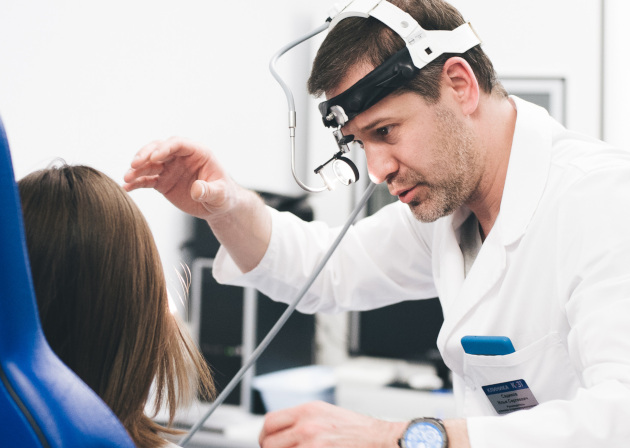Nose bleed

specialists

equipment

treatment
Causes of nosebleeds
Common reasons
Common reasons include:
- Cardiovascular diseases.
- Hormonal imbalance.
- Blood diseases.
- Overheating in the sun (sunstroke) or high temperature due to illness.
- High pressure differences in the environment (climbers, divers).
Local factors
Most often, bleeding is caused by injury: domestic, industrial and road injuries (a seat belt will protect you from contact with the steering wheel or dashboard). Bleeding can also be caused by a foreign body (children often suffer) or medical procedures - nasogastric intubation, nasotracheal intubation, etc.
- Tumors (specific granulomas, angiomas, etc.) also cause bleeding in the nasal cavity.
- Conditions accompanied by congestion of the mucous membrane (sinusitis, rhinitis, adenoids).
- Impaired functionality of the mucous membrane (deviated nasal septum, atrophic rhinitis).
Stage of purulent inflammation
System factors
- Allergies.
- ARI, ARVI.
- Lifestyle that provokes regular changes in pressure.
- Hormonal imbalances.
- Persistently high blood pressure.
- Bad habits (smoking, alcohol abuse, drugs).
- Diseases of the blood, liver, heart.
- Side effects of various drugs.
- Physical fatigue, overheating.
General information about nosebleeds
Kinds

Nosebleeds are divided into acute and chronic.
Acute bleeding often leads to complications (for example, oxygen deprivation can cause loss of consciousness).
Chronic bleeding, if left untreated, sometimes even leads to death.
Anterior bleeding
By location, bleeding can be anterior or posterior. “Anterior” bleeding is not intense, stops on its own or with a little help and is completely safe for life.
Posterior bleeding
The cause of posterior bleeding is damage to large blood vessels in the nasal cavity. Large blood loss is possible, so you need to immediately call qualified doctors - you won’t be able to stop it on your own.

Nosebleeds in children
Children are more susceptible to nosebleeds. This happens for several reasons:
- The mucous membrane is damaged or injured by the child himself.
- Intense physical activity.
- Factors of hormonal changes.
- Runny nose and infectious diseases.
- Sun and heat stroke.
- Avitaminosis.
Of more serious reasons, it is worth highlighting various tumors and liver diseases. Children also suffer from low blood clotting.
Nosebleeds in adults
There are many causes of nosebleeds in adults; to determine the specific one, a visit to the doctor and examination are necessary. At best, this may be a mild pathology in a completely healthy person, but you should not neglect your health.
Adults and children have different causes of the problem. Blood can enter the sinuses through the respiratory tract, esophagus, or even the stomach. The nasal mucosa is extensively dotted with small vessels and capillaries of the blood supply, but regular bleeding from the sinuses almost certainly indicates some serious disease. It is imperative to find out the source of the problem. To do this you need to undergo a medical examination.

How is an appointment with an otolaryngologist at K+31?
Our doctors

This award is given to clinics with the highest ratings according to user ratings, a large number of requests from this site, and in the absence of critical violations.

This award is given to clinics with the highest ratings according to user ratings. It means that the place is known, loved, and definitely worth visiting.

The ProDoctors portal collected 500 thousand reviews, compiled a rating of doctors based on them and awarded the best. We are proud that our doctors are among those awarded.
Make an appointment at a convenient time on the nearest date
Price



































About the disease
The term “nosebleed” refers to the leakage of blood from the nasal cavity. In eighty percent, it occurs at the Kisselbach point (anteroinferior cartilaginous section of the septum). However, in reality, everything is much more complicated than it seems at first glance - in the most severe cases, blood can rise through the nasolacrimal ducts and flow out through the eye sockets. Also, with severe bleeding, blood enters the respiratory tract or gastrointestinal tract through the esophagus and provokes vomiting.
Some people experience bleeding unexpectedly, while others feel dizzy or have a headache and a ringing in the ears. It is important not to confuse it - there is a possibility of bleeding from other organs (trachea, pharynx, lungs, larynx or even middle ear). The blood from the nose is clean, homogeneous, and contains no clots or inclusions.